The Role of Women in a Family Economy. A Bibliometric Analysis in Contexts of Poverty
Abstract
1. Introduction
2. Literature Review
2.1. Studies on Poverty and Family Economy
2.2. Family Economy and Modes of Production: Domestic Work
2.3. Gender Relations and Reproduction in the Context of the Family Economy
3. Data and Methodology
Main Stages in the Process
4. Results and Discussion
4.1. Evolution of Scientific Production
4.2. Analysis of Scientific Production by Areas: Journals, Authors, and Countries
4.2.1. Distribution of Publications by Subject Area and Journal
4.2.2. Productivity of Authors
4.2.3. Main Institutions and Countries
4.3. Keyword Analysis
5. Conclusions
Author Contributions
Funding
Conflicts of Interest
References
- Godelier, M. The concept of the asian mode of production and the marxist model of social development. Sov. Anthropol. Archeol. 1965, 4, 39–41. [Google Scholar] [CrossRef]
- Godelier, M. Work and its representations: A research proposal. Hist. Work. J. 1980, 10, 164–174. [Google Scholar] [CrossRef]
- Pérez, A.G. Cambios políticos y sociales de la familia. Psicol. Política 2014, 49, 27–57. [Google Scholar]
- Meillassoux, C. From reproduction to production. Econ. Soc. 1972, 1, 93–105. [Google Scholar] [CrossRef]
- Harvey, D. Land Rent and the Transition to the Capitalist Mode of Production. Antipode 1982, 14, 17–25. [Google Scholar] [CrossRef]
- Banaji, J. Modes of Production in a Materialist Conception of History. Cap. Cl. 1977, 1, 1–44. [Google Scholar] [CrossRef]
- Hart, K. Informal income opportunities and urban employment in ghana. J. Mod. Afr. Stud. 1973, 11, 61–89. [Google Scholar] [CrossRef]
- Reed, E.; Donta, B.; Dasgupta, A.; Ghule, M.; Battala, M.; Nair, S.; Silverman, J.; Jadhav, A.; Palaye, P.; Saggurti, N.; et al. Access to Money and Relation to Women’s Use of Family Planning Methods Among Young Married Women in Rural India. Matern. Child Health J. 2016, 20, 1203–1210. [Google Scholar] [CrossRef]
- Amin, R.; Pierre, M.S.; Ahmed, A.; Haq, R. Integration of an essential services package (ESP) in child and reproductive health and family planning with a micro-credit program for poor women: Experience from a pilot project in Rural Bangladesh. World Dev. 2001, 29, 1611–1621. [Google Scholar] [CrossRef]
- Corroon, M.; Speizer, I.S.; Fotso, J.C.; Akiode, A.; Saad, A.; Calhoun, L.; Irani, L. The role of gender empowerment on reproductive health outcomes in urban nigeria. Matern. Child Health J. 2014, 18. [Google Scholar] [CrossRef]
- Do, M.; Kurimoto, N. Women’s empowerment and choice of contraceptive methods in selected African countries. Int. Perspect. Sex. Reprod. Health 2012, 38. [Google Scholar] [CrossRef] [PubMed]
- Nash, R. Bourdieu on Education and Social and Cultural Reproduction. Br. J. Sociol. Educ. 1990, 11, 431–447. [Google Scholar] [CrossRef]
- Hartmann, H. Family Theory: Feminist–Economist Critique. Int. Encycl. Soc. Behav. Sci. 2001, 5392–5397. [Google Scholar]
- Coelho, T.P. Subdesenvolvimento e dependência: Um debate entre o pensamento da Cepal dos anos 50s e a Teoria da Dependência. Perspect. Sociol. Rev. Profr. Sociol. 2016, 1. [Google Scholar] [CrossRef]
- Santos, T. Dos The structure of dependence. In The Gap Between Rich and Poor: Contending Perspectives on the Political Economy of Development; Routledge: London, UK, 2019. [Google Scholar]
- Wallerstein, I. Dependence in an interdependent world: The limited possibilities of transformation within the capitalist world economy. Afr. Stud. Rev. 1974, 17, 1–26. [Google Scholar] [CrossRef]
- Hopkins, T.K.; Wallerstein, I. Processes of the World-System; Sage Publications, Inc.: Newbury Park, CA, USA, 1980; ISBN 9780803913790. [Google Scholar]
- Frank, A.G. Development and underdevelopment in the new world: Smith and Marx vs. the Weberians. Theory Soc. 1975, 2, 431–466. [Google Scholar] [CrossRef]
- Sunkel, O. The Development of Development Thinking. IDS Bull. 1977, 8, 6–12. [Google Scholar] [CrossRef]
- Veiga, U.M. Historia de la Antropología, Teorías, Praxis y Lugares de Estudio; Universidad Nacional de Educación a Distancia (UNED): Madrid, Spain, 2008. [Google Scholar]
- Wolf, E.R. Europa y la Gente Sin Historia; Fondo de Cultura Económica: México City, Mexico, 1993; p. 254. [Google Scholar]
- de’Argemir, D.C. Antropología Económica; Ariel: Barcelona, Spain, 1998; ISBN 84-344-2212-3. [Google Scholar]
- Williamson, D.L.; Reutter, L. Defining and measuring poverty: Implications for the health of Canadians. Health Promot. Int. 1999, 14, 355–364. [Google Scholar] [CrossRef]
- Halik, M.; Webley, P. Adolescents’ understanding of poverty and the poor in rural Malaysia. J. Econ. Psychol. 2011, 32, 231–239. [Google Scholar] [CrossRef]
- Murali, V.; Oyebode, F. Poverty, social inequality and mental health. Adv. Psychiatr. Treat. 2004, 10, 216–224. [Google Scholar] [CrossRef]
- Faye, A.; Bob, M.; Fall, A.; Fall, C. Primary Health Care and the Millennium Development Goals. Med. Sante Trop. 2019, 22. [Google Scholar] [CrossRef] [PubMed]
- González, L.S. From industrial restructuring to the financial crisis: Mainstream nationalism and minimum income in the Basque Country. Soc. Policy Adm. 2020, 54, 539–555. [Google Scholar] [CrossRef]
- Subirats, J. Social exclusion and devolution among Spanish autonomous communities. Reg. Fed. Stud. 2005, 15, 471–483. [Google Scholar] [CrossRef]
- Zugasti, N.; Laparra, M. Measuring poverty at the regional level in Spain: A reflexive approach | Midiendo la pobreza a nivel autonómico en España. Una propuesta reflexive. Rev. Esp. Investig. Sociol. 2017, 158, 117–136. [Google Scholar] [CrossRef]
- Hanum, N.; Muda, I. Analysis of structural poverty trend among rice farmers in east aceh regency, Indonesia. Glob. Bus. Financ. Rev. 2019, 24. [Google Scholar] [CrossRef]
- Fair, C.C.; Littman, R.; Malhotra, N.; Shapiro, J.N. Relative Poverty, Perceived Violence, and Support for Militant Politics: Evidence from Pakistan. Polit. Sci. Res. Methods 2018, 6, 57–81. [Google Scholar] [CrossRef]
- Navarro, D.M.; Robles, J.N.; Hernández, L.O. Women in Mexico: Inequality, poverty and violence. Rev. Mex. Cienc. Polit. Soc. 2014, 59. [Google Scholar] [CrossRef]
- Sheldon, R. Hunger: A modern history—By James Vernon. Econ. Hist. Rev. 2008, 61. [Google Scholar] [CrossRef]
- Hickel, J. The true extent of global poverty and hunger: Questioning the good news narrative of the Millennium Development Goals. Third World Q. 2016, 37, 749–767. [Google Scholar] [CrossRef]
- Rahmah, S.Z.; Wonoadi, G.L.; Zulfikar, A. The Implementation of MDGs Program on Eradication of Extreme Poverty and Hunger in Indonesia (2009–2014). J. Ilm. Hub. Int. 2019, 15, 75–88. [Google Scholar] [CrossRef]
- Sutter, C.; Bruton, G.D.; Chen, J. Entrepreneurship as a solution to extreme poverty: A review and future research directions. J. Bus. Ventur. 2019, 34, 197–214. [Google Scholar] [CrossRef]
- Si, S.; Ahlstrom, D.; Wei, J.; Cullen, J. Business, Entrepreneurship and Innovation Toward Poverty Reduction. Entrep. Reg. Dev. 2020, 32. [Google Scholar] [CrossRef]
- Kuzudisli, A. Ali Kuzudisli Fight Against Poverty From the Islamic Point of View: The Wealth Distribution and Share. Econ. World 2017, 5, 9–15. [Google Scholar] [CrossRef][Green Version]
- Nili, S. Global poverty, global sacrifices, and natural resource reforms. Int. Theory 2019, 11, 48–80. [Google Scholar] [CrossRef]
- Khandker, S. Micro-Finance and Poverty: Evidence Using Panel Data from Bangladesh. World Bank Policy Res. Work. Pap. 2003. [Google Scholar] [CrossRef]
- Niño-Zarazúa, M. Microcredit, Labor, and Poverty Impacts in Urban Mexico. Rev. Dev. Econ. 2013, 17, 747–762. [Google Scholar] [CrossRef]
- Ukanwa, I.; Xiong, L.; Anderson, A. Experiencing microfinance: Effects on poor women entrepreneurs’ livelihood strategies. J. Small Bus. Enterp. Dev. 2018, 25. [Google Scholar] [CrossRef]
- Kaztman, R.; Retamoso, A. Residential Segregation in Montevideo: Challenges to Educational Equality; Palgrave Macmillan: New York, NY, USA, 2009; ISBN 9780230620841. [Google Scholar]
- Hareven, T.K.; Zeller, O. The history of the family and the complexity of social change. Part 1 | L’histoire de la famille et la complexité du changement social (parte 1). Cah. Hist. 2000, 45, 9–34. [Google Scholar]
- Jean, B. Land, territory, territoriality: Farmers and their attachment to territory|Terre, territoire, territorialite: Les agriculteurs et leur attachement au territoire. Cah. Geogr. Que. 1993, 37, 291–307. [Google Scholar] [CrossRef][Green Version]
- Ellis, F. Household strategies and rural livelihood diversification. J. Dev. Stud. 1998, 35, 1–38. [Google Scholar] [CrossRef]
- World Bank. Averting the Old Age Crisis: Policies to Protect the Old and Promote Growth; World Bank: Washington, DC, USA, 1994; ISBN 9780195209969. [Google Scholar]
- Ellis, F. The determinants of rural livelihood diversification in developing countries. J. Agric. Econ. 2000, 51, 289–302. [Google Scholar] [CrossRef]
- Cavendish, W. Empirical regularities in the poverty-environment relationship of rural households: Evidence from Zimbabwe. World Dev. 2000, 28, 1979–2003. [Google Scholar] [CrossRef]
- Narayan, D.; Pritchett, L. Cents and sociability: Household income and social capital in rural Tanzania. Econ. Dev. Cult. Chang. 1999, 47, 870–897. [Google Scholar] [CrossRef]
- Ravallion, M.; Chen, S. What can new survey data tell us about recent changes in distribution and poverty? World Bank Econ. Rev. 1997, 11, 357–382. [Google Scholar] [CrossRef]
- Angelsen, A.; Jagger, P.; Babigumira, R.; Belcher, B.; Hogarth, N.J.; Bauch, S.; Börner, J.; Smith-Hall, C.; Wunder, S. Environmental Income and Rural Livelihoods: A Global-Comparative Analysis. World Dev. 2014, 64, S12–S28. [Google Scholar] [CrossRef] [PubMed]
- Rawlings, L.B.; Rubio, G.M. Evaluating the impact of conditional cash transfer programs. World Bank Res. Obs. 2005, 20, 29–55. [Google Scholar] [CrossRef]
- Reardon, T.; Berdegué, J.; Escobar, G. Rural nonfarm employment and incomes in Latin America: Overview and policy implications. World Dev. 2001, 29, 395–409. [Google Scholar] [CrossRef]
- De Janvry, A.; Sadoulet, E. Income strategies among rural households in Mexico: The role of off-farm activities. World Dev. 2001, 29, 467–480. [Google Scholar] [CrossRef]
- Kyrk, H. The economics of consumption as a field for research in agricultural economics: Discussion by hazel kyrk. Am. J. Agric. Econ. 1929, 11, 575–577. [Google Scholar] [CrossRef]
- Reid, M.G. The Economic Contribution of Homemakers1. Ann. Am. Acad. Pol. Soc. Sci. 1947, 251, 61–69. [Google Scholar] [CrossRef]
- LeClair, E.E. Economic Theory and Economic Anthropology. Am. Anthropol. 1962, 64. [Google Scholar] [CrossRef]
- Herskovits, M.J. Economics and Anthropology: A Rejoinder. J. Polit. Econ. 1941, 49. [Google Scholar] [CrossRef]
- Polanyi, K. The Great Transformation; Blackwell Publishers: Boston, MA, USA, 2008; ISBN 9780470755679. [Google Scholar]
- Polanyi, K. The Economy as Instituted Process; Westview Press: New York, NY, USA, 2018; ISBN 9780429962882. [Google Scholar]
- Sahlins, M. Stone Age Economics; Routledge: London, UK, 2013; ISBN 9780203037416. [Google Scholar]
- REDFIELD, R. Culture changes in yucatan. Am. Anthropol. 1934, 36, 57–69. [Google Scholar] [CrossRef]
- Redfield, R. The natural history of the folk society. Soc. Forces 1953, 31, 224–228. [Google Scholar] [CrossRef]
- Bartolomé, L.J.; Chayanov, A.V.; Rússovich, R.M.; Bartolome, L.J.; Russovich, R.M. La organización de la unidad económica campesinaLa organizacion de la unidad economica campesina. Desarro. Econ. 1974, 14. [Google Scholar] [CrossRef]
- Friedmann, H. World Market, State, and Family Farm: Social Bases of Household Production in the era of Wage Labor. Comp. Stud. Soc. Hist. 1978, 20, 545–586. [Google Scholar] [CrossRef]
- Gerstel, N.; Collins, J.L.; Gimenez, M. Work Without Wages: Comparative Studies of Domestic Labor and Self-Employment Within Capitalism. Contemp. Sociol. 1991, 20. [Google Scholar] [CrossRef]
- Gallin, R.S.; Aronoff, M.; Ferguson, A. The Women and International Development Annual; Routledge: London, UK, 2019. [Google Scholar]
- Molyneaux, M. Beyond the Domestic Labour Debate. New Left Rev. 1979, 116, 3–27. [Google Scholar]
- Mingione, E.; Pinnaro, G. Work and Social Reproduction: Two Concepts for Interpreting the Post-Fordist Transition. Labour 1993, 7, 175–198. [Google Scholar] [CrossRef]
- Fainstein, N.; Mingione, E.; Goodrick, P. Fragmented Societies: A Sociology of Economic Life beyond the Market Paradigm. Contemp. Sociol. 1993, 22. [Google Scholar] [CrossRef]
- Allan, H.; Morris, L. The Workings of the Household. Br. J. Sociol. 1991, 42. [Google Scholar] [CrossRef]
- Roldan, M. Industrial outworking, struggles for the reproduction of working class families and gender subordination. In Beyond Employment: Household, Gender and Subsistence; Basil Blackwell: Oxford, UK, 1985; pp. 248–285. [Google Scholar]
- Beneria, L.; Beneria, L. Women’s Participation in Paid Production Under Capitalism: The Spanish Experience. Rev. Radic. Polit. Econ. 1976, 8, 18–33. [Google Scholar] [CrossRef]
- Benería, L. Reproduction, production and the sexual division of labour. Camb. J. Econ. 1979, 3, 203–225. [Google Scholar] [CrossRef]
- Edholm, F.; Harris, O.; Young, K. Conceptualising Women. Crit. Anthropol. 1978, 3, 101–130. [Google Scholar] [CrossRef]
- Tilly, L.A.; Scott, J.W.; Cohen, M. Women’s work and European fertility patterns. J. Interdiscip. Hist. 1976, 6, 447–476. [Google Scholar] [CrossRef]
- Tilly, L.A. The Social Sciences and the Study of Women: A Review Article. Comp. Stud. Soc. Hist. 1978, 20, 163–173. [Google Scholar] [CrossRef]
- Marx, K. Capital; Taylor and Francis: London, UK, 2016; ISBN 9781317687184. [Google Scholar]
- Gravili, G.; Avram, A.; Nicolescu, A.C. Gender Equality and Firm Financial Performance: The Case of Central and Eastern Europe Financial and IT&C Sectors. In Proceedings of the 2nd International Conference on Gender Research, Porto, Portugal, 11–12 April 2019. [Google Scholar]
- Harris, O.; Young, K. Engendered Structures: Some Problems in the Analysis of Reproduction. In The Anthropology of Pre-Capitalist Societies; Macmillan Education: London, UK, 1981; pp. 109–147. [Google Scholar]
- Yanagisako, S.J. women-centered kin networks in urban bilateral kinship. Am. Ethnol. 1977, 4, 207–226. [Google Scholar] [CrossRef]
- Collier, J.F.; Yanagisako, S.J. Theory in anthropology since feminist practice. Crit. Anthropol. 1989, 9, 27–37. [Google Scholar] [CrossRef]
- Polanco, H.D. Reseña de “Mujeres, graneros y capitales” de Claude Meillassoux. Nueva Antropol. 1977, 2, 103–108. [Google Scholar]
- Moore, H.; Moore, H.L. Households and Gender in a South African Bantustan A Comment. Afr. Stud. 1994, 53, 137–142. [Google Scholar] [CrossRef]
- Hansen, K.T. Work without Wages: Domestic Labor and Self-Employment within Capitalism. Jane L. Collins and Martha Gimenez, Eds. Am. Ethnol. 1992, 19. [Google Scholar] [CrossRef]
- Belmonte-Urenã, L.J.; Garrido-Cardenas, J.A.; Camacho-Ferre, F. Analysis of world research on grafting in horticultural plants. HortScience 2020, 55, 112–120. [Google Scholar] [CrossRef]
- Abad-Segura, E.; Cortés-García, F.J.; Belmonte-Ureña, L.J. The sustainable approach to corporate social responsibility: A global analysis and future trends. Sustainability 2019, 11, 5382. [Google Scholar] [CrossRef]
- Abad-Segura, E.; Morales, M.E.; Cortés-García, F.J.; Belmonte-Ureña, L.J. Industrial Processes Management for a Sustainable Society: Global Research Analysis. Processes 2020, 8, 631. [Google Scholar] [CrossRef]
- Meseguer-Sánchez, V.; Abad-Segura, E.; Belmonte-Ureña, L.J.; Molina-Moreno, V. Examining the research evolution on the socio-economic and environmental dimensions on university social responsibility. Int. J. Environ. Res. Public Health 2020, 17, 4729. [Google Scholar] [CrossRef] [PubMed]
- Duque-Acevedo, M.; Belmonte-Ureña, L.J.; Cortés-García, F.J.; Camacho-Ferre, F. Agricultural waste: Review of the evolution, approaches and perspectives on alternative uses. Glob. Ecol. Conserv. 2020, 22, e00902. [Google Scholar] [CrossRef]
- Bender, L.D.; Green, B.L. Negative taxation and poverty. Can. J. Agric. Econ. Can. D’agroecon. 1968, 16, 112–121. [Google Scholar] [CrossRef]
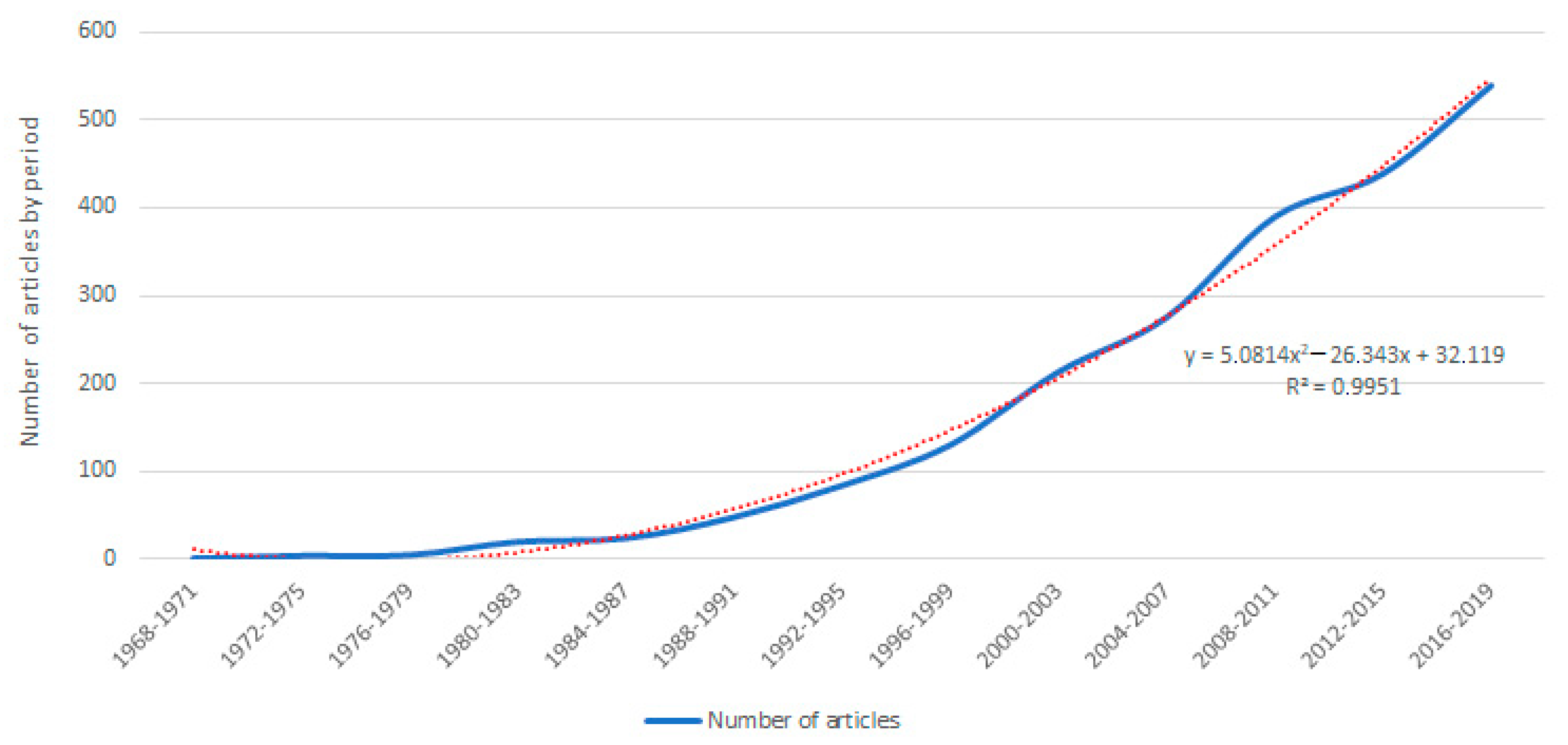
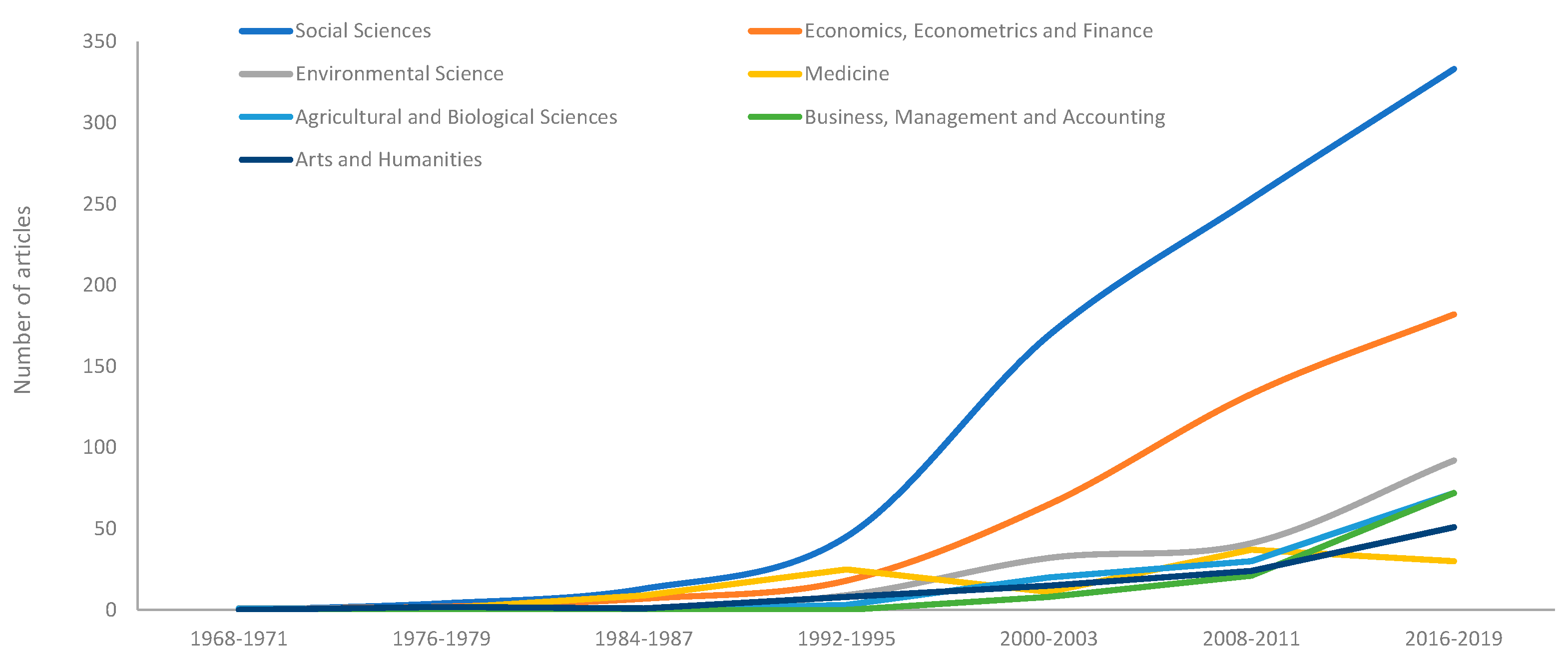
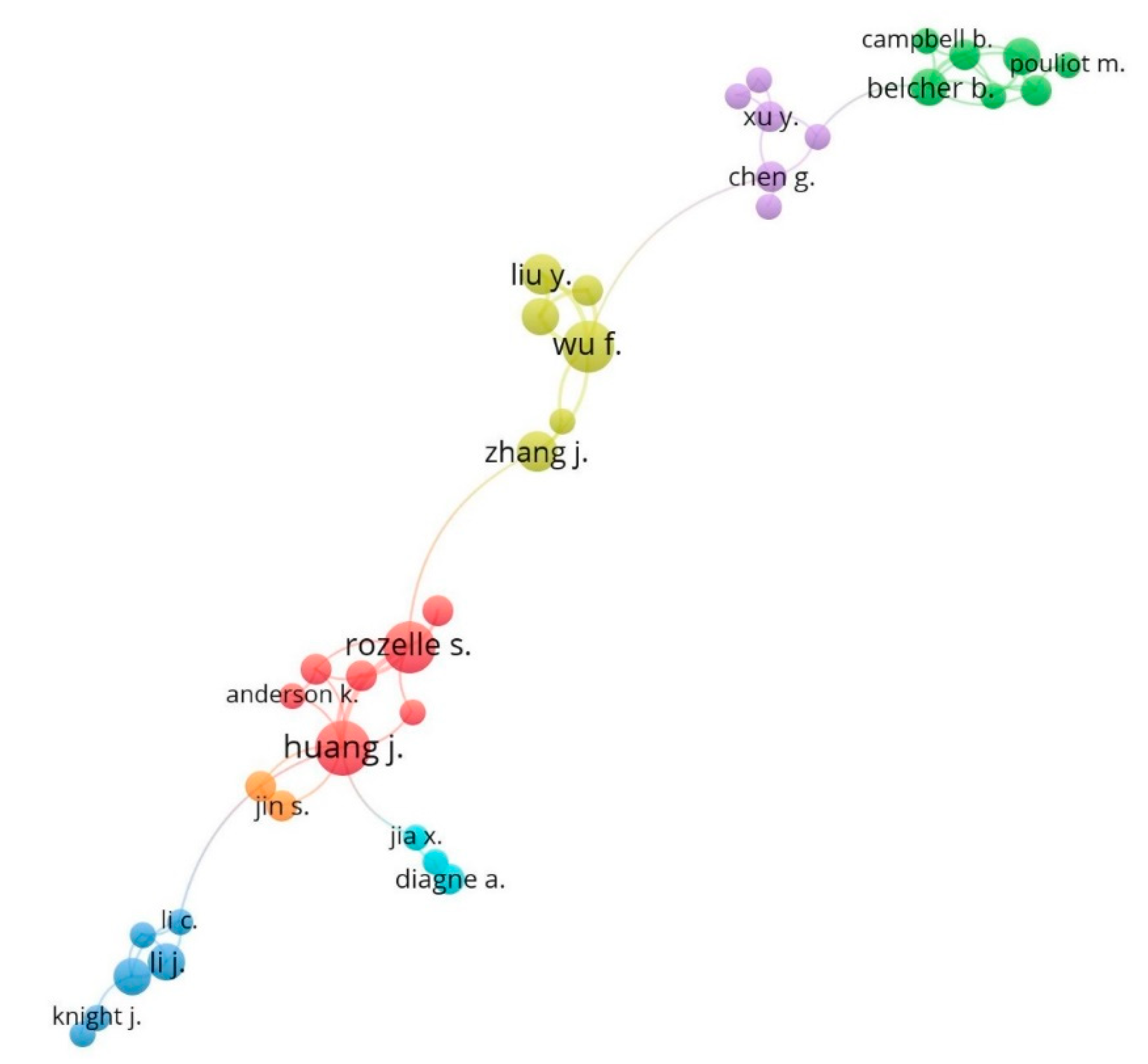
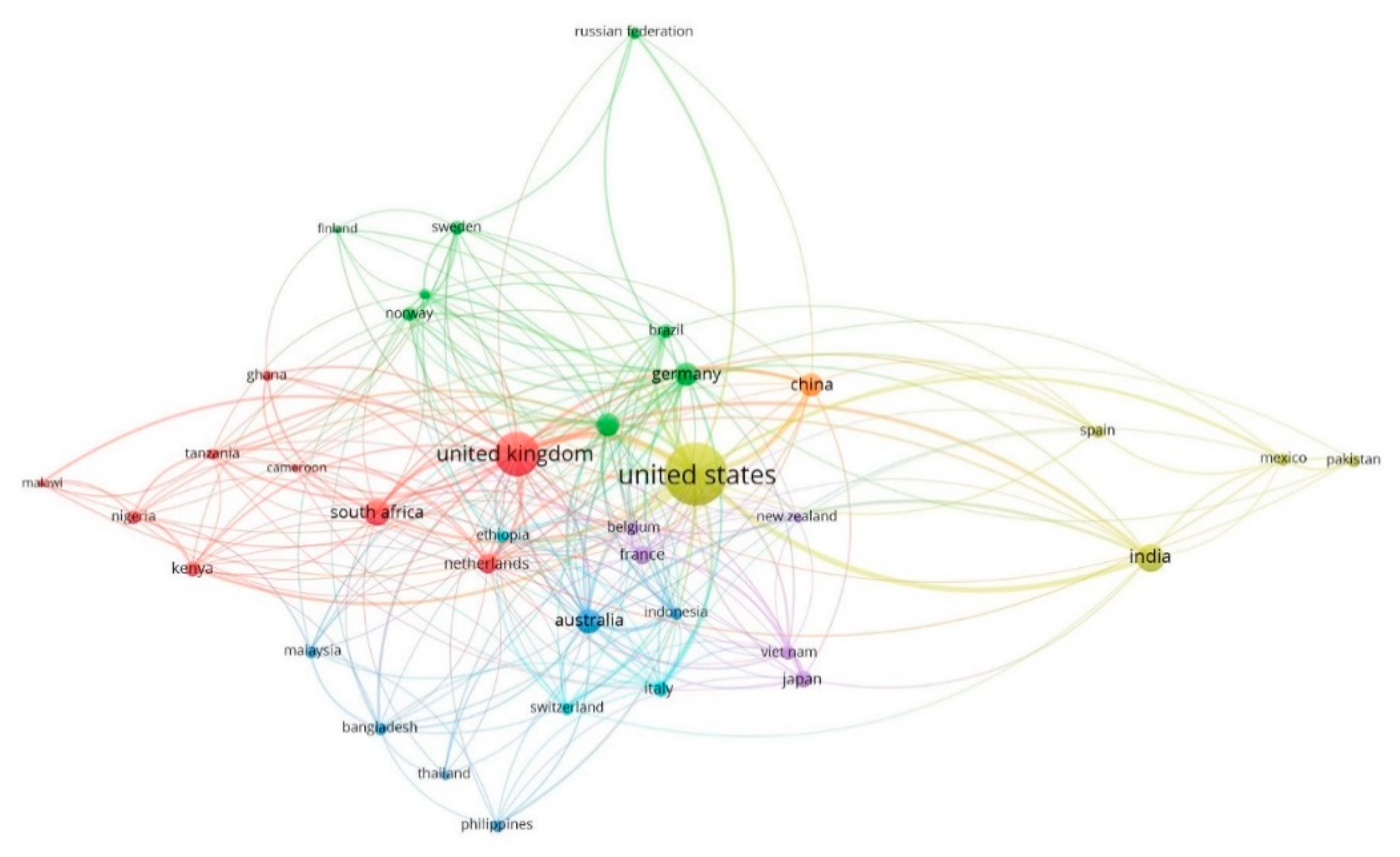
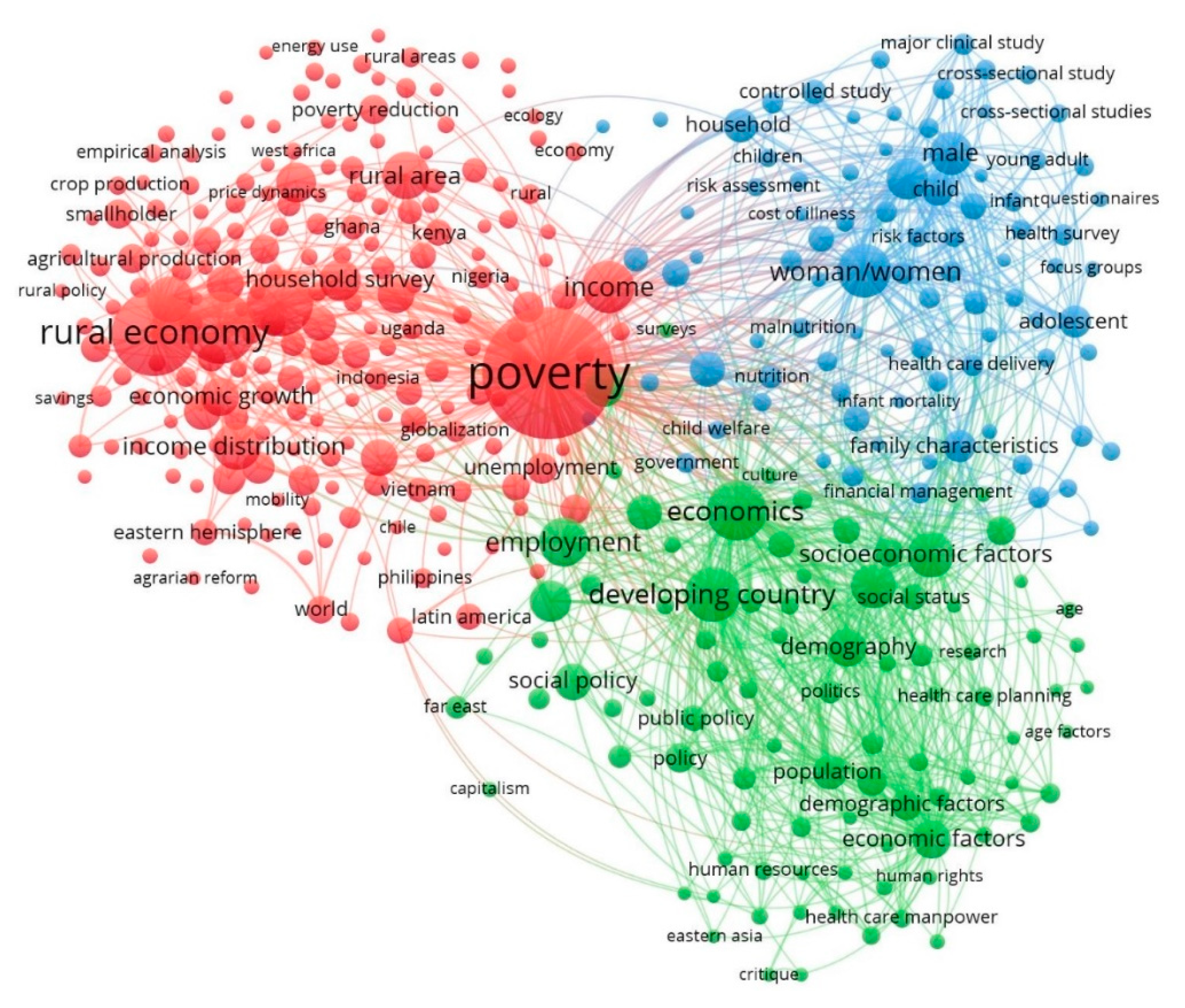
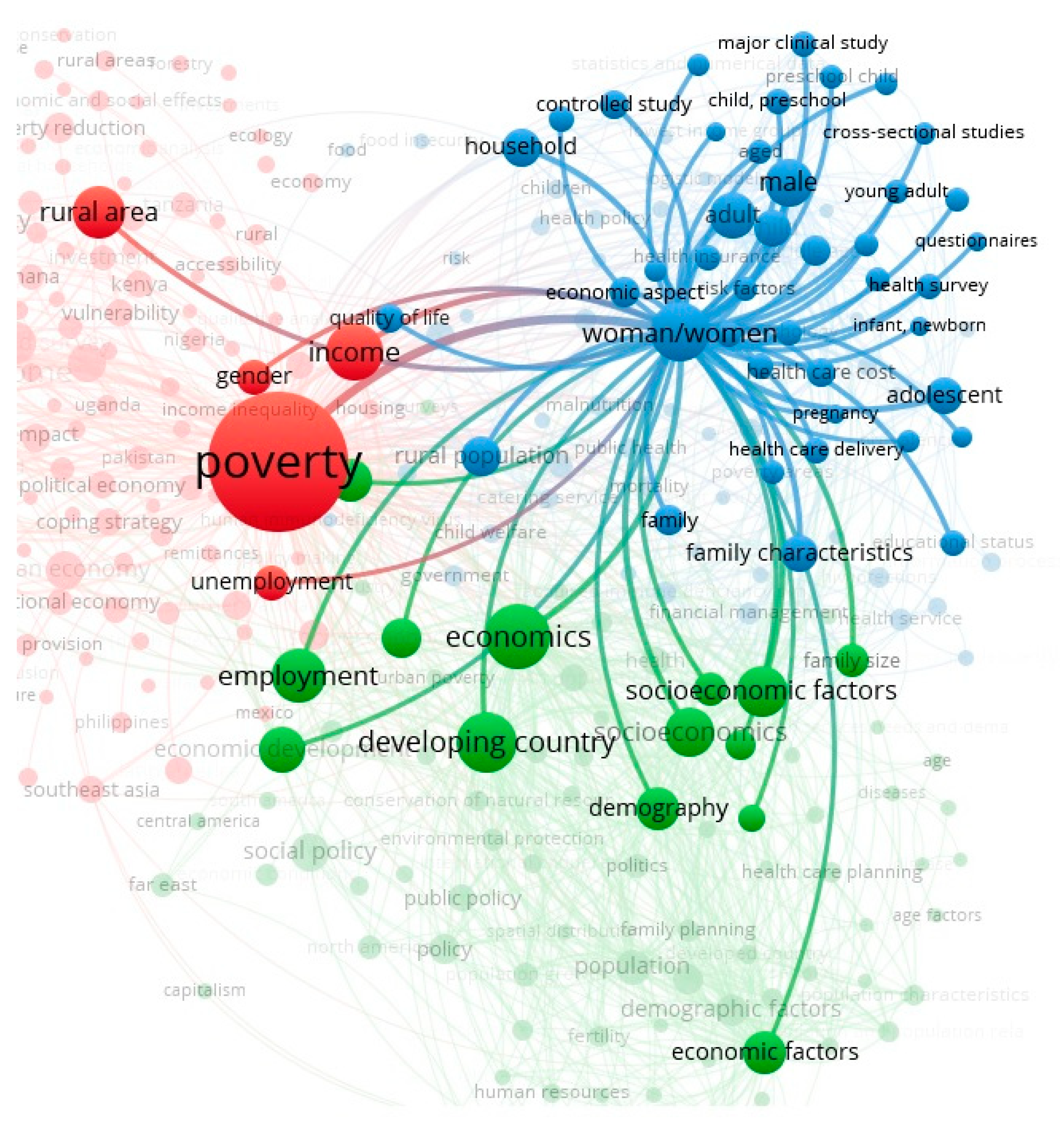
| Year | Article Title [Reference] | Journal | Author(s) | Cites |
|---|---|---|---|---|
| 1998 | Household strategies and rural livelihood diversification [46] | Journal of Development Studies | Ellis, F. | 1027 |
| 1994 | Averting the old age crisis: policies to protect the old and promote growth [47] | Averting the old age crisis: policies to protect the old and promote growth | World Bank | 472 |
| 2000 | The determinants of rural livelihood diversification in developing countries [48] | Journal of Agricultural Economics | Ellis, F. | 424 |
| 2000 | Empirical regularities in the poverty-environment relationship of rural households: Evidence from Zimbabwe [49] | World Development | Cavendish, W. | 402 |
| 1999 | Cents and sociability: Household income and social capital in rural Tanzania [50] | Economic Development and Cultural Change | Narayan, D., Pritchett, L. | 402 |
| 1997 | What can new survey data tell us about recent changes in distribution and poverty? [51] | World Bank Economic Review | Ravallion, M., Chen, S. | 372 |
| 2014 | Environmental Income and Rural Livelihoods: A Global-Comparative Analysis [52] | World Development | Angelsen, A., Jagger, P., Babigumira, R., (...), Smith-Hall, C., Wunder, S. | 366 |
| 2005 | Evaluating the impact of conditional cash transfer programs [53] | World Bank Research Observer | Rawlings, L.B., Rubio, G.M. | 254 |
| 2001 | Rural nonfarm employment and incomes in Latin America: Overview and policy implications [54] | World Development | Reardon, T., Berdegué, J., Escobar, G. | 249 |
| 2001 | Income strategies among rural households in Mexico: The role of off-farm activities [55] | World Development | De Janvry, A., Sadoulet, E. | 230 |
| Stages of the Process | Selection Criteria | Results |
|---|---|---|
| 1. Pre-analysis | 1.1. Search and analysis of the term family economy and poverty in databases. | (TITLE-ABS-KEY (“family” or “household”) AND TITLE-ABS-KEY (economy) AND TITLE-ABS-KEY (poverty)) AND DOCTYPE (ar OR bk OR ch) AND PUBYEAR <2020 |
| 1.2. Verification of the publication period and the papers’ coincidence with the conceptual term and research field. | SCOPUS—2182 document results | |
| 2. Data exploitation (categorization and coding) | 2.1. Analysis of the amount and typology of the documents contained in SCOPUS database. | SCOPUS—2182 document results |
| 3. Processing of the outcome | 3.1. Assessment of the type of analysis, indicators and adequate tools for scientific mapping through VOSViewer | Indicators and bibliometric maps with VOSViewer - Document and authorship - Networking maps of relationship between authors - Co-occurrence of keywords - Evolution timeline of papers’ publication - Approaches identified in the literature review |
| Period | A | AU | C | TC | TC/A | J |
|---|---|---|---|---|---|---|
| 1968–1971 | 2 | 3 | 2 | 1 | 0.5 | 2 |
| 1972–1975 | 5 | 7 | 3 | 15 | 3.0 | 4 |
| 1976–1979 | 6 | 7 | 3 | 59 | 9.8 | 6 |
| 1980–1983 | 21 | 27 | 7 | 203 | 9.7 | 17 |
| 1984–1987 | 25 | 29 | 9 | 165 | 6.6 | 23 |
| 1988–1991 | 49 | 68 | 7 | 736 | 15.0 | 44 |
| 1992–1995 | 85 | 109 | 17 | 1890 | 22.2 | 71 |
| 1996–1999 | 131 | 187 | 24 | 4148 | 31.7 | 107 |
| 2000–2003 | 214 | 377 | 56 | 7413 | 34.6 | 132 |
| 2004–2007 | 276 | 571 | 69 | 6763 | 24.5 | 180 |
| 2008–2011 | 390 | 829 | 79 | 6725 | 17.2 | 285 |
| 2012–2015 | 439 | 1044 | 80 | 4864 | 11.1 | 336 |
| 2016–2019 | 539 | 1397 | 94 | 1781 | 3.3 | 381 |
| Journal | A | TC | TC/A | Ha | Hj | SJR(Q) | Country | First | Last | R (A) | ||||
|---|---|---|---|---|---|---|---|---|---|---|---|---|---|---|
| Article | Article | 00–03 | 04–07 | 08–11 | 12–15 | 16–19 | ||||||||
| World Development | 75 | 3590 | 47.87 | 34 | 164 | 2.223(Q1) | United Kingdom | 1983 | 2019 | 1(18) | 2(9) | 4(8) | 2(8) | 1(20) |
| Journal of African Economies | 44 | 822 | 18.68 | 16 | 44 | 0.853(Q1) | United Kingdom | 1993 | 2018 | 17(2) | 3(8) | 1(17) | 1(10) | 23(3) |
| Journal of Development Studies | 41 | 2533 | 61.78 | 22 | 79 | 0.916(Q1) | United Kingdom | 1988 | 2019 | 4(6) | 1(11) | 3(8) | 3(7) | 13(4) |
| International Journal of Social Economics | 25 | 85 | 3.40 | 5 | 37 | 0.278(Q2) | United Kingdom | 1998 | 2019 | 31(1) | 110(1) | 36(2) | 5(5) | 2(15) |
| Food Policy | 22 | 1060 | 48.18 | 16 | 95 | 2.189(Q1) | United Kingdom | 1995 | 2018 | 2(8) | 5(6) | 53(1) | 33(2) | 20(3) |
| Social Science and Medicine | 22 | 1089 | 49.50 | 16 | 229 | 1.944(Q1) | United Kingdom | 1985 | 2019 | 8(5) | 7(5) | -- | 16(3) | 16(4) |
| Energy Policy | 19 | 550 | 28.95 | 10 | 197 | 2.168(Q1) | United Kingdom | 1993 | 2019 | 32(1) | 30(2) | 28(2) | 30(2) | 4(10) |
| Journal of Development Economics | 15 | 685 | 45.67 | 12 | 133 | 3.585(Q1) | Netherlands | 1995 | 2019 | -- | 9(4) | 41(2) | 60(1) | 8(5) |
| Social Indicators Research | 15 | 50 | 3.33 | 6 | 99 | 0.875(Q1) | Netherlands | 1982 | 2019 | -- | 40(2) | -- | 61(1) | 3(11) |
| Economic Development and Cultural Change | 14 | 936 | 66.86 | 13 | 67 | 3.483(Q1) | United States | 1997 | 2013 | 5(5) | 82(1) | 11(3) | 62(1) | -- |
| Journal of International Development | 14 | 223 | 15.93 | 8 | 64 | 0.611(Q1) | United Kingdom | 1990 | 2019 | 6(5) | 35(2) | 9(4) | -- | 67(1) |
| Pakistan Development Review | 14 | 89 | 6.36 | 6 | 22 | 0.143(Q4) | Pakistan | 1991 | 2018 | 3(8) | 142(1) | -- | -- | 68(1) |
| Developing Economies | 11 | 79 | 7.18 | 4 | 26 | 0.294(Q3) | United States | 2006 | 2017 | -- | 26(2) | 22(2) | 4(6) | 69(1) |
| Development Southern Africa | 11 | 212 | 19.27 | 8 | 39 | 0.384(Q2) | United Kingdom | 1992 | 2016 | -- | 10(3) | 54(1) | 27(2) | 70(1) |
| Plos One | 11 | 106 | 9.64 | 7 | 300 | 1.023(Q1) | United States | 2014 | 2019 | -- | -- | -- | 6(5) | 7(6) |
| Development and Change | 10 | 191 | 19.10 | 8 | 87 | 1.052(Q1) | United Kingdom | 1991 | 2018 | -- | 27(2) | 23(2) | -- | 19(3) |
| Ecological Economics | 10 | 332 | 33.20 | 9 | 189 | 1.719(Q1) | Netherlands | 1996 | 2018 | 33(1) | 29(2) | 7(4) | 63(1) | 71(1) |
| Economics of Transition | 10 | 167 | 16.70 | 7 | 48 | 0.466(Q2) | United Kingdom | 1998 | 2014 | 34(1) | 6(5) | -- | 29(2) | -- |
| Geoforum | 10 | 188 | 18.80 | 8 | 107 | 1.616(Q1) | United Kingdom | 1986 | 2019 | -- | 32(2) | 55(1) | 35(2) | 41(2) |
| Journal of Rural Studies | 10 | 339 | 33.90 | 7 | 96 | 1.624(Q1) | United Kingdom | 1994 | 2018 | -- | 51(1) | -- | 47(2) | 5(6) |
| Authors | A | C | C/A | Institutions | Country | First Article | Last Article | h Index |
|---|---|---|---|---|---|---|---|---|
| Ravallion, M. | 9 | 311 | 34.56 | University of Malaya | Malaysia | 1995 | 2008 | 9 |
| Sadoulet, E. | 9 | 190 | 21.11 | University of California | United States | 1989 | 2009 | 8 |
| Lanjouw, P. | 8 | 164 | 20.50 | Vrije Universiteit Amsterdam | Netherlands | 1995 | 2004 | 8 |
| Huang, J. | 7 | 93 | 13.29 | Jiangxi Agricultural University | China | 2003 | 2014 | 6 |
| Rozelle, S. | 7 | 101 | 14.43 | Stanford University | United States | 2003 | 2017 | 7 |
| Barrett, C.B. | 6 | 103 | 17.17 | Cornell University | United States | 1999 | 2018 | 5 |
| Crush, J. | 6 | 117 | 19.50 | Wilfrid Laurier University | South Africa | 2011 | 2016 | 5 |
| De Janvry, A. | 6 | 114 | 19.00 | University of California | United States | 1977 | 2011 | 5 |
| Waibel, H. | 6 | 63 | 10.50 | Gottfried Wilhelm Leibniz Universität Hannover | Germany | 2011 | 2017 | 4 |
| Wu, F. | 6 | 52 | 8.67 | University College London | United Kingdom | 2006 | 2010 | 6 |
| Institution | C | A | TC | TC/A | h-Index | IC (%) | TCIC | TCNIC |
|---|---|---|---|---|---|---|---|---|
| The World Bank | United States | 83 | 3580 | 43.1 | 31 | 54.22% | 53.11 | 31.32 |
| International Food Policy Research Institute | United States | 40 | 670 | 16.8 | 16 | 62.50% | 11.84 | 24.93 |
| University of Oxford | United Kingdom | 32 | 318 | 9.9 | 12 | 43.75% | 11.43 | 8.78 |
| University of Cape Town | South Africa | 29 | 575 | 19.8 | 13 | 51.72% | 23.80 | 15.57 |
| University of Sussex | United Kingdom | 24 | 400 | 16.7 | 11 | 45.83% | 20.18 | 13.69 |
| Cornell University | United States | 21 | 431 | 20.5 | 11 | 47.62% | 35.20 | 7.18 |
| University of California | United States | 19 | 1135 | 59.7 | 14 | 31.58% | 57.67 | 60.69 |
| Wageningen University & Research | Netherlands | 18 | 427 | 23.7 | 11 | 77.78% | 23.21 | 25.50 |
| University of KwaZulu-Natal | South Africa | 18 | 373 | 20.7 | 10 | 38.89% | 33.29 | 12.73 |
| The University of Manchester | United Kingdom | 16 | 490 | 30.6 | 11 | 37.50% | 44.33 | 22.40 |
| Country | A | TC | TC/A | h-Index | R (A) | ||||
|---|---|---|---|---|---|---|---|---|---|
| 2000–2003 | 2004–2007 | 2008–2011 | 2012–2015 | 2016–2019 | |||||
| United States | 593 | 12,659 | 21.35 | 65 | 1(60) | 1(103) | 1(114) | 1(118) | 1(121) |
| United Kingdom | 304 | 7813 | 25.70 | 47 | 2(45) | 2(52) | 2(55) | 2(67) | 2(59) |
| India | 123 | 1371 | 11.15 | 22 | 5(7) | 6(13) | 5(23) | 5(31) | 3(43) |
| South Africa | 106 | 1757 | 16.58 | 25 | 10(6) | 7(11) | 9(16) | 3(35) | 5(34) |
| Australia | 91 | 1471 | 16.16 | 23 | 11(5) | 12(6) | 7(20) | 4(32) | 7(21) |
| Germany | 87 | 1579 | 18.15 | 23 | 3(8) | 11(7) | 8(17) | 6(19) | 6(31) |
| China | 85 | 891 | 10.48 | 19 | 13(4) | 8(10) | 4(23) | 10(14) | 4(34) |
| Canada | 81 | 1836 | 22.67 | 24 | 9(6) | 5(13) | 6(21) | 7(17) | 8(18) |
| Netherlands | 64 | 1569 | 24.52 | 25 | 8(7) | 4(16) | 10(13) | 9(15) | 26(9) |
| France | 54 | 353 | 6.54 | 11 | 12(5) | 10(8) | 15(8) | 8(15) | 9(18) |
| Country | NC | Main Collaborators | IC (%) | TC/A | |
|---|---|---|---|---|---|
| IC | NIC | ||||
| United States | 66 | United Kingdom. China, India, Australia, and Germany. | 32.88% | 24.94 | 19.59 |
| United Kingdom | 58 | United States, China, India, Germany, and Netherlands. | 42.43% | 21.94 | 28.47 |
| India | 14 | United States, United Kingdom, Australia, South Africa, and Germany. | 32.52% | 18.50 | 7.60 |
| South Africa | 29 | United Kingdom, United States, Canada, France, and Germany. | 37.74% | 20.45 | 14.23 |
| Australia | 24 | United States, Indonesia, India, Canada, and United Kingdom. | 50.55% | 24.35 | 7.80 |
| Germany | 36 | United States, United Kingdom, Ethiopia, Indonesia, and Italy. | 54.02% | 19.57 | 16.48 |
| China | 16 | United States, United Kingdom, Canada, Australia, and France. | 52.94% | 16.84 | 3.33 |
| Canada | 33 | United States, Australia, South Africa, United Kingdom, and China. | 44.44% | 29.39 | 17.29 |
| Netherlands | 36 | United States, United Kingdom, Belgium, Ethiopia, and Germany. | 60.94% | 23.62 | 25.92 |
| France | 27 | United States, United Kingdom, Belgium, Brazil, and Canada. | 55.56% | 10.20 | 1.96 |
| Keyword | 1968–2019 | 1976–1979 | 1992–1995 | 2000–2003 | 2008–2011 | 2016–2019 | ||||||
|---|---|---|---|---|---|---|---|---|---|---|---|---|
| A | % | R (A) | % | R (A) | % | R (A) | % | R (A) | % | R (A) | % | |
| Poverty | 860 | 39.4% | 3(2) | 33.3% | 4(30) | 35.3% | 1(89) | 41.6% | 1(150) | 38.5% | 1(217) | 40.3% |
| Rural-economy | 354 | 16.2% | 183(2) | 2.4% | 2(79) | 7.0% | 2(66) | 16.9% | 2(72) | 13.4% | ||
| Poverty-alleviation | 265 | 12.1% | 33(6) | 7.1% | 3(51) | 23.8% | 3(60) | 15.4% | 4(58) | 10.8% | ||
| Household-income | 217 | 9.9% | 59(5) | 5.9% | 4(26) | 12.1% | 8(35) | 9.0% | 3(63) | 11.7% | ||
| Economics | 177 | 8.1% | 15(1) | 16.7% | 5(29) | 34.1% | 18(10) | 4.7% | 17(22) | 5.6% | 7(42) | 7.8% |
| Developing-country | 155 | 7.1% | 11(1) | 16.7% | 1(53) | 62.4% | 136(3) | 1.4% | 71(8) | 2.1% | 27(17) | 3.2% |
| Woman/women | 142 | 6.5% | 103(3) | 3.5% | 38(6) | 2.8% | 21(19) | 4.9% | 11(32) | 5.9% | ||
| Income | 136 | 6.2% | 121(3) | 3.5% | 5(16) | 7.5% | 27(16) | 4.1% | 9(36) | 6.7% | ||
| Employment | 124 | 5.7% | 21(10) | 11.8% | 7(15) | 7.0% | 19(21) | 5.4% | 18(26) | 4.8% | ||
| Rural-area | 116 | 5.3% | 32(7) | 3.3% | 14(23) | 5.9% | 6(42) | 7.8% | ||||
| Income-distribution | 112 | 5.1% | 319(1) | 1.2% | 8(14) | 6.5% | 10(29) | 7.4% | 14(27) | 5.0% | ||
| Socioeconomic-factors | 106 | 4.9% | 38(1) | 16.7% | 9(19) | 22.4% | 28(7) | 3.3% | 25(16) | 4.1% | 51(12) | 2.2% |
| Sub-Saharan-Africa | 106 | 86(3) | 1.4% | 9(32) | 8.2% | 129(7) | 1.3% | |||||
| Socioeconomics | 103 | 4.7% | 40(1) | 16.7% | 11(18) | 21.2% | 46(6) | 2.8% | 24(17) | 4.4% | 50(12) | 2.2% |
| Male | 96 | 4.4% | 126(3) | 3.5% | 39(6) | 2.8% | 32(13) | 3.3% | 12(30) | 5.6% | ||
| Economic-development | 88 | 4.0% | 13(1) | 16.7% | 13(13) | 15.3% | 44(6) | 2.8% | 55(9) | 2.3% | 25(22) | 4.1% |
| Adult | 86 | 3.9% | 208(2) | 2.4% | 27(7) | 3.3% | 33(13) | 3.3% | 16(27) | 5.0% | ||
| Household-survey | 85 | 3.9% | 57(5) | 2.3% | 13(25) | 6.4% | 13(29) | 5.4% | ||||
| Food-security | 80 | 3.7% | 497(1) | 1.2% | 19(9) | 4.2% | 22(18) | 4.6% | 17(26) | 4.8% | ||
| Agriculture | 78 | 3.6% | 4(1) | 16.7% | 28(7) | 8.2% | 25(8) | 3.7% | 57(9) | 2.3% | 20(24) | 4.5% |
| Demography | 78 | 3.6% | 10(1) | 16.7% | 8(19) | 22.4% | 146(3) | 1.4% | 54(9) | 2.3% | 182(5) | 0.9% |
| Economic-factors | 76 | 3.5% | 14(1) | 16.7% | 6(27) | 31.8% | 84(4) | 1.9% | 587(2) | 0.4% | ||
| Economic-growth | 76 | 3.5% | 397(1) | 1.2% | 113(3) | 1.4% | 15(23) | 5.9% | 34(15) | 2.8% | ||
| Rural-development | 71 | 3.3% | 159(2) | 2.4% | 42(6) | 2.8% | 40(11) | 2.8% | 24(22) | 4.1% | ||
| Sustainability | 71 | 3.3% | 402(1) | 1.2% | 162(2) | 0.9% | 364(2) | 0.5% | 67(11) | 2.0% | ||
Publisher’s Note: MDPI stays neutral with regard to jurisdictional claims in published maps and institutional affiliations. |
© 2020 by the authors. Licensee MDPI, Basel, Switzerland. This article is an open access article distributed under the terms and conditions of the Creative Commons Attribution (CC BY) license (http://creativecommons.org/licenses/by/4.0/).
Share and Cite
Meseguer-Sánchez, V.; López-Martínez, G.; Molina-Moreno, V.; Belmonte-Ureña, L.J. The Role of Women in a Family Economy. A Bibliometric Analysis in Contexts of Poverty. Sustainability 2020, 12, 10328. https://doi.org/10.3390/su122410328
Meseguer-Sánchez V, López-Martínez G, Molina-Moreno V, Belmonte-Ureña LJ. The Role of Women in a Family Economy. A Bibliometric Analysis in Contexts of Poverty. Sustainability. 2020; 12(24):10328. https://doi.org/10.3390/su122410328
Chicago/Turabian StyleMeseguer-Sánchez, Víctor, Gabriel López-Martínez, Valentín Molina-Moreno, and Luis Jesús Belmonte-Ureña. 2020. "The Role of Women in a Family Economy. A Bibliometric Analysis in Contexts of Poverty" Sustainability 12, no. 24: 10328. https://doi.org/10.3390/su122410328
APA StyleMeseguer-Sánchez, V., López-Martínez, G., Molina-Moreno, V., & Belmonte-Ureña, L. J. (2020). The Role of Women in a Family Economy. A Bibliometric Analysis in Contexts of Poverty. Sustainability, 12(24), 10328. https://doi.org/10.3390/su122410328







